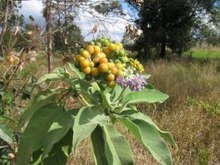Woolly nightshade
| Woolly nightshade | ||||||||||||
|---|---|---|---|---|---|---|---|---|---|---|---|---|

Woolly nightshade ( Solanum mauritianum ) - flower |
||||||||||||
| Systematics | ||||||||||||
|
||||||||||||
| Scientific name | ||||||||||||
| Solanum mauritianum | ||||||||||||
| Scop. |
The woolly nightshade ( Solanum mauritianum ) is a species from the genus of the nightshade ( Solanum ). In large areas of the tropics, the species is considered invasive . All parts of the plant are poisonous to humans.
description
The woolly nightshade is a 2 to 4 meter high, often branched shrub or small tree that gives off a strong odor.
The simple, entire, ovate-elliptical leaves are up to 40 centimeters long and 30 centimeters wide. The tip of the leaf is pointed, the base is wedge-shaped. They sit on 3 to 9 centimeters long petioles. They are dense, tomentose with hairy yellowish, long-stemmed, star-shaped trichomes .
The inflorescences are umbels of purple single flowers and sit on 15 centimeter long inflorescence axes. The sepals are fused into a 2 to 3 millimeter long calyx tube with 1 to 2 millimeter long lobes. The crown is star-shaped and measures between 1.5 and 2.5 centimeters. The five stamens sit on 1 millimeter long filaments . The anthers are egg-shaped and 2 to 3.5 millimeters long.
After flowering, spherical yellow berries up to 2 cm in size with numerous, flattened seeds 1.5 to 2 millimeters long form .
The number of chromosomes is 2n = 24.
distribution
The species thrives above all in particularly exposed locations on roads and in the vicinity of settlements up to 700 meters in height.
The natural range of the woolly nightshade is in Uruguay and south-east Brazil. There are now neophytic occurrences in almost all tropical regions of the world, especially on the Pacific Islands, in Australia, New Zealand, on Reunion, Rarotonga, the Cook Islands, in Bhutan, on Tonga, in almost all of Africa, on Madagascar, Hawaii and the Atlantic Islands . Smaller deposits were also found in Taiwan.
In many of these areas, such as the Azores , the species is considered invasive . In South Africa, biological pest control is used to combat them.
Toxicity
All parts of Solanum mauritianum , especially the berries, are poisonous to humans. The main toxic components are glycoalkaloids and solasodine . The highest proportion of these substances is contained in the unripe berries (2% to 3.5% of the dry matter).
swell
literature
- William G. D'Arcy, Ching-I Peng: Solanum mauritianum . In: Flora of Taiwan . (English, online [accessed January 29, 2011]).
- Hanno Schäfer: Flora of the Azores . Margraf Verlag, Weikersheim, ISBN 3-8236-1368-5 , p. 166 (English).
- Andreas Stieglitz: Azores flora. The flora of the Azores . Books on Demand, Norderstedt, ISBN 3-8334-0888-X , p. 74 .
- Erik Sjogren: Plants and Flowers of the Azores . Os Montanheiros, Velas 2001, p. 170 .
Individual evidence
- ↑ Solanum mauritianum at Tropicos.org. In: IPCN Chromosome Reports . Missouri Botanical Garden, St. Louis
- ↑ RF Vieira: Avaliação do teor de solasodina em frutos verdes de Solanum mauritianum Scop. sob dois solos no estado do Paraná, Brazil . Universidade Federal do Paraná, Curitiba 1989 (Spanish).

